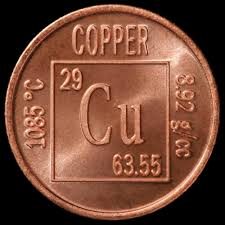 Copper (Cu) is an extremely useful industrial metal that is ductile (capable of being drawn into wire), malleable (capable of being hammered and molded) and an excellent conductor of electricity.
Copper (Cu) is an extremely useful industrial metal that is ductile (capable of being drawn into wire), malleable (capable of being hammered and molded) and an excellent conductor of electricity.






Cu – Copper
Discovered in: Antiquity
Discovered by: Unknown
Description: The origins of its name unknown. Copper is one of the first metals to be used, largely because it occurs in metallic form at the surface. By 4000 B.C., it was being smelted from ores in Israel and other parts of the Middle East. Copper is a malleable, ductile reddish metal, and is one of only two strongly colored metals (gold being the other). Copper is a stable metal largely unaffected by water and air, although carbon dioxide will react with the surface of pure copper to form greenish copper carbonate. Copper is an excellent conductor of electricity (second only to silver) and electrical motors, generators and wiring are its primary use. Copper is also used in ornamentation, coins and as a building material, especially in plumbing and roofing. Many pounds of copper are used in each automobile in radiators and electronic wiring. American police officers are nicknamed cops or coppers due to the copper buttons their uniforms used to have. Copper sulfate (blue vitriol) is used as an agricultural poison and a water purifier. Copper’s symbol Cu comes from its Latin name, cuprum.
Biological Rating: Necessary for full health of plants and animals.
Biological Benefits: Copper is a necessary trace element to all species. It is a key component of certain enzymes and interacts with iron as hemocyanin, which is important in red blood cell production. The nervous system and bones also need copper. Copper is important to the sense of taste and copper has a distinctive taste that can be detected at very small concentrations.
Percentage Amount in the Human Body: 0.0001%
Obtained From: Copper is a common element in many minerals and commonly occurs in pure, native form. Most of the world’s copper comes from the minerals chalcopyrite and chalcocite. Chrysocolla and malachite also are mined for copper. Other copper-bearing minerals include atacamite, azurite, bornite, brochantite, cuprite (copper oxide), dioptase, rosasite and tetrahedrite.




















